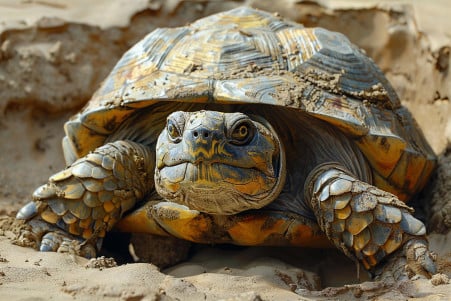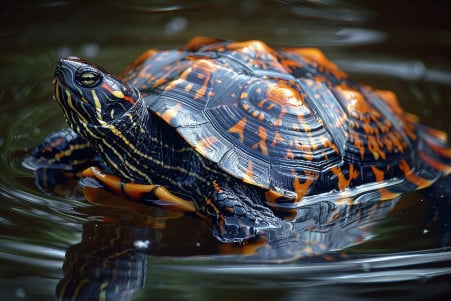Are Turtles Reptiles or Amphibians? Unveiling Their Classification
9 February 2024 • Updated 9 February 2024

Turtles live in both water and on land, but how are they classified? Herpetologists have determined that turtles are reptiles, not amphibians. Turtles are a member of the order Testudines, which is a group of reptiles. Turtles have scales, breathe air with lungs, and most species lay hard-shelled eggs on land—all of which are reptilian traits.
This article will take a deep dive into herpetological studies to explore the defining characteristics and evolutionary evidence that clearly place turtles within the reptilian branch of the animal kingdom.
We will look at biological research, paleontological evidence, and comparative anatomical evidence to explain the clear differences between reptiles and amphibians. This will help you understand the science behind these findings and give you a more complete understanding of these interesting animals and where they belong in the natural world.
Are turtles reptiles or amphibians?
How to Tell Reptiles and Amphibians Apart: Important Characteristics and Conservation Implications
Despite being ectotherms and often living in similar environments, reptiles and amphibians are vastly different in terms of their physiology. Reptiles are known for their scaly skin and primarily terrestrial life cycle; for example, many reptiles, including turtles, lay eggs with hard shells on land.
On the other hand, amphibians have skin that must be kept moist and typically go through a life cycle that starts in water as gilled larvae and ends on land as air-breathing adults, according to BYJU’S.
Reptiles have also evolved a range of reproductive modes, including oviparity (egg-laying) and viviparity (live birth), which separates them from amphibians, all of which lay their eggs in water and go through metamorphosis, according to Discover Wildlife. Meanwhile, Dictionary.com explains that the skin of amphibians is moist and their eggs are fertilized externally, which is the opposite of reptiles like turtles, which have dry, keratinous skin and internal fertilization.
Accurate classification is important for conservation, especially since both reptiles and amphibians are threatened by habitat loss. This makes it important to know the specific needs of reptiles, including turtles, to ensure their survival and the survival of other species.
It also helps to know the evolutionary history of these animals to understand why turtles’ characteristics are more similar to other reptiles, which confirms their classification and the need for conservation efforts aimed at them.
Evolutionary History: Turtles’ Prehistoric Origins
Turtles are not newcomers to the world, having lived alongside the dinosaurs. According to the Natural History Museum, the first turtles evolved in the Triassic period, around 230 million years ago, and have been considered reptiles for their entire evolutionary history.
As described in Britannica, the fossil record indicates that prehistoric turtles like the Odontochelys semitestacea already had a complete plastron and broad dorsal ribs, which are clear signs of their reptilian status. The one thing they didn’t have was a fully formed carapace, which suggests that the turtles’ defining characteristic evolved over time.
As Darwin’s Door observes, the turtles’ ability to survive mass extinctions that have wiped out many other species has shown their resilience. This resilience is reflected in their long history, with the split between the two main groups of turtles, Cryptodira and Pleurodira, going back at least to the Triassic period.
Research published in Palaeontology has further supported the turtles’ adaptability and survival. This research has shown that turtles have been able to adapt to major changes in the climate, which is a common characteristic of many reptiles. The evolution of turtles from animals with partial shells to the fully shelled animals we know today demonstrates that they haven’t just survived but thrived by adapting to the world around them.
Looking at turtles’ physiology in more detail, it becomes clear that their anatomy and genetics are closely tied to the reptile family, which sets them apart from amphibians and firmly places them in the reptile family.
Understanding Turtle Anatomy: The Reptilian Body Plan
Turtle anatomy demonstrates some incredible adaptations that are consistent with reptilian characteristics, including their most obvious feature, the shell. This protective covering is a fusion of the rib cage, spine, vertebrae, and sternum, as shown by Business Insider, and is actually part of the turtle’s skeleton.
In fact, the turtle’s shoulder and hip girdles are inside the rib cage, a fact that was confirmed by a paper on PubMed by Hiroshi Nagashima, and is unique among land animals. The carapace and plastron, the top and bottom parts of the shell, are evolutionary novelties that are a departure from the typical tetrapod body plan.
Turtles also have a unique respiratory system; unlike most land animals, they don’t use their ribs to breathe. Instead, they use the muscles inside their shells to help them breathe, as shown by Business Insider. In addition, turtles can breathe underwater through their cloaca, which acts like gills, when they’re hibernating. This flexibility is a sign of their resilience and their reptilian heritage.
Turtle Time, Inc. pointed out the differences in the skeletal structure of sea turtles, which have a fused spine and flipper digits, which help anchor their muscles. This is in contrast to amphibians, which have much more flexible skeletons. The fusion of the turtle’s spine to the carapace, except in leatherbacks, and the structure of their limbs are important clues that show that turtles are reptiles.
The resilience and complexity of these physiological characteristics are evidence of the turtle’s survival and help explain their life cycles and reproductive behaviors.
How Do Turtles Reproduce? From Eggs to the Sea
Turtle reproduction is incredibly diverse and includes a wide variety of behaviors and life cycles that are characteristic of reptiles. This is in contrast to amphibians, which are mostly dependent on water for reproduction. Turtles lay eggs with hard shells on land.
Britannica describes the many different mating behaviors and egg-laying habits of turtles, some of which can reach sexual maturity in just a few years and others that take many decades. Female turtles are known for their careful nest-building and often travel long distances to lay their eggs, which are then left to develop on their own.
Temperature-dependent sex determination is one of the most important aspects of turtle reproduction, including sea turtles, and is described by The State of the World’s Sea Turtles. The sex of the offspring is determined by the temperature at which the eggs are incubated, and this has major implications for conservation.
As the climate changes and temperatures rise, the sex ratios of turtle populations are changing, making it difficult to maintain populations that are healthy and sustainable.
Knowing the many different ways that turtles reproduce is important for their conservation. It helps us understand what we need to do to protect these ancient creatures and makes it clear that we need to protect their habitats and work to stop climate change. This knowledge not only confirms that turtles are reptiles but also helps us work to ensure that they continue to thrive in the world’s oceans.
Saving Ancient Mariners: The Importance of Taxonomy in Turtle Conservation
The difference between reptiles and amphibians isn’t just an academic one—it also matters for the conservation of turtles. According to Discover Wildlife, it’s important to recognize turtles as reptiles when it comes to conservation because it means that conservation efforts can be tailored to the specific ecological needs of turtles. For example, knowing that turtles lay their eggs on beaches informs the protection of nesting sites.
Turtle populations are increasingly threatened by habitat loss, poaching, and climate change, which can impact their sex ratios due to changes in the temperature at which eggs are incubated.
Conservation efforts that are based on this knowledge, such as protecting nesting sites and regulating fishing, are essential to the survival of turtles. For example, the Olive Ridley Project has had success with their conservation efforts because they’ve used their understanding of the turtles’ life cycle to inform their conservation efforts.
These examples show how taxonomy can inform successful conservation efforts. By understanding that turtles are reptiles, conservationists can better understand the unique challenges that need to be addressed to ensure their survival, which in turn can help inform the study and protection of the world’s biodiversity.
Solving the Riddle: Turtles Are Reptiles
From the evidence presented, it is clear that turtles are reptiles. Turtles possess all the classic reptile characteristics of scaly skin, the ability to lay eggs with hard shells on land, and lungs for breathing. Their extensive fossil history shows a lineage that goes back to the Triassic period, which is further evidence of their reptilian status.
The investigation into turtle anatomy has shown that their shells are a unique adaptation but are still made of the same components as other reptiles. Turtles also have many physiological traits that are typical of reptiles. For example, they have a well-developed respiratory system and temperature-dependent sex determination, which is a reproductive strategy shared by other reptiles but not amphibians.
Recognizing turtles as reptiles has important implications for herpetological research and conservation. It means that conservationists can focus on the specific needs of turtles to ensure that their efforts to protect these ancient reptiles are successful. In the end, it is important to recognize the importance of turtles as an evidence of the diversity and resilience of reptiles, rather than a biological oddity.


